Nasal Analysis & Anatomy in Virginia, Washington D.C. and Maryland.
To reduce your risk of requiring a Revision Rhinoplasty, you should read the following facts very carefully. Rhinoplasty is a surgical procedure. That may sound obvious but there is a very important message in that simple phrase.
Embark on a journey of aesthetic excellence with The Naderi Center. Experience unparalleled artistry and precision for transformative beauty.
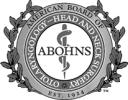
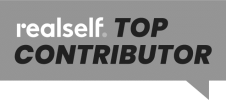
Importance of Precise Nasal Diagnosis in Rhinoplasty
All surgeries are forms of treatment, whether elective or otherwise. Surgery is meant to correct a problem. But what many Plastic Surgeons fail to carry out is the crucial steps prior to the actual treatment – the diagnosis of the precise cause of each nose problem. Too often Plastic Surgeons perform a “routine” or “cookie cutter” Rhinoplasty. Sometimes this approach leads to a nice outcome but often the end point is disappointing results. Each nose is unique. Each problem is different and many times correction of one issue may lead to creation of another one that has to be predicted, and accounted for, and treated. Plastic Surgeons must stop focusing on “open Rhinoplasty” versus “closed Rhinoplasty” and stop worrying about “selling” the procedure to their patients, and instead spend time thoroughly analyzing the nose and pinpointing exactly what needs to be fixed, as well as discussing what should be left alone. This approach yields satisfying results and happy patients.
For an analogy, your family doctor has to first diagnose the cause of high blood sugar before treating it with the proper medication. In the same way, your Plastic Surgeon has to first precisely diagnose the cause of a nasal “deformity” before treating it with Rhinoplasty. A patient’s complaint of a “droopy tip” can be due to a variety of factors such as an extra-long caudal septum, or weak tip support, or an over developed anterior septal angle or due to dynamic muscle forces during smiling or the “droopy tip” may be an illusion due to a large dorsal hump. The proper cause has to be diagnosed because the various surgical techniques used during a Rhinoplasty to correct each problem, are very different. If the proper cause is not diagnosed initially, the Rhinoplasty treatment will not only fail to correct the problem but very likely may create a whole new set of problems which will require a reconstructive Revision Rhinoplasty down the line.
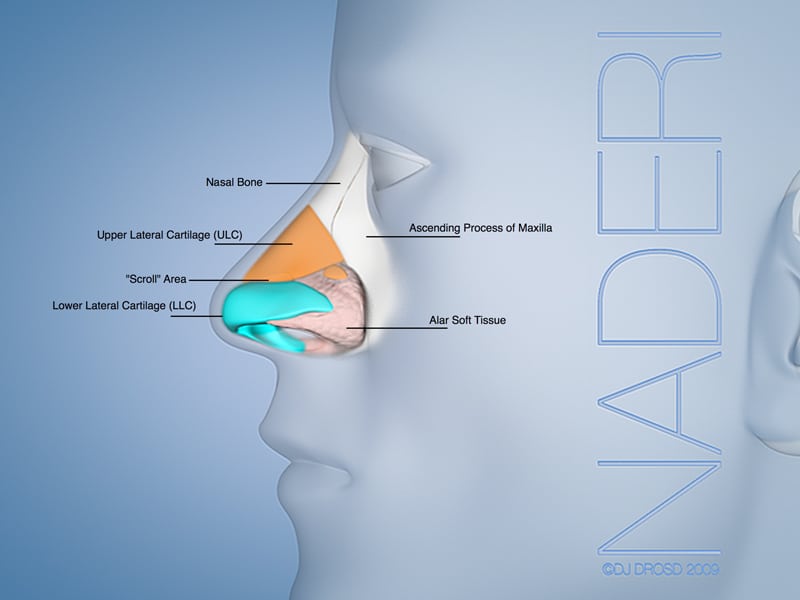

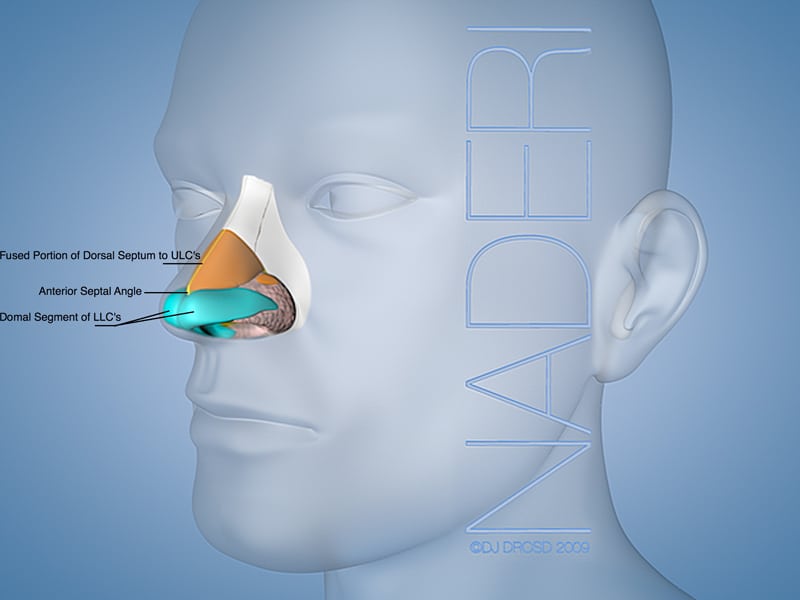

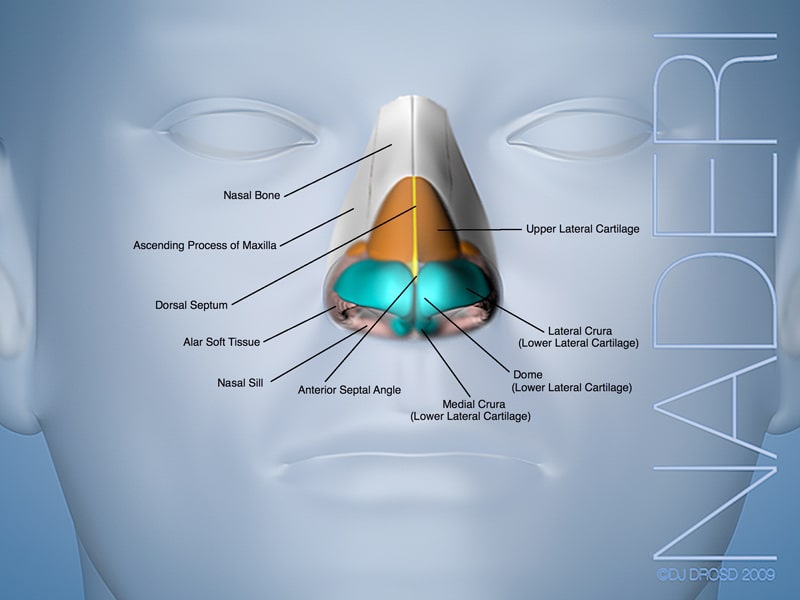
So the take home massage is the initial key to a successful Rhinoplasty or Revision Rhinoplasty is accurate analysis and diagnosis. Good surgical technique, complete understanding of the nose and its anatomy, as well as a thorough doctor-patient dialogue using digital computer imaging, are other keys to success. But too often analysis and diagnosis are neglected by the novice Plastic Surgeon. A Rhinoplasty Surgeon, who has dedicated his or her entire career to Rhinoplasty and Revision Rhinoplasty, understands the importance of these key factors. For me, nasal analysis begins either in person, during the in-office consultation, or online by reviewing photos of out of town patients desiring phone consultation. Analysis of the nose starts with analysis of the entire face, body and even behavior. The nose does not sit in a vacuum. The nose has to fit everything else. Here are some general rules but please note that there are plenty of exceptions to these rules, which makes computer imaging so important during the consultation dialogue. We will discuss these issues in depth under specific sections in this online textbook of Rhinoplasty.
Accurate Analysis for Optimal Rhinoplasty Results
- The sex and age of each patient as well as their ethnicity will influence what changes will best fit their face with a Rhinoplasty or Revision Rhinoplasty. For example, an older African-American male patient will require a different looking nose, and a different surgical approach than a teenage Caucasian female patient. As the end goals are different so are the surgical maneuvers. Yet, the essential desire for a more improved, beautiful, and natural looking nose that “fits” is universally shared.
- In general, men, as well as patients above 50 years of age, often benefit from less drastic changes; with a more conservative surgical plan.
- The height and sex of the patient must be taken into account when planning changes to the nasal length, bridge contour, as well as tip rotation. Male Rhinoplasty patients and taller patients require stronger and more natural nose bridges with less upturned tips. The shorter the patient, the “cutesier” the nose can be with slightly more tip rotation during a Rhinoplasty. A “Barbie doll nose” may fit on a 5’1” blond female but will never look good on a 6’3” Italian male.
- Patients with larger, rounder faces need noses that are “softer” compared to patients with chiseled, angular, or thin faces.
- Facial asymmetries and portions must be taken into consideration. 85% of people have significant facial asymmetry. The base-view-photograph best demonstrates these variations from side to side. It is almost universal for the left and right mid-face, cheek and eyes to be in different positions on the face. These asymmetries are very common and do not always create unappealing faces. But it is important to note these asymmetries. Many of the most popular and beautiful actors and celebrities have significant facial asymmetry. The nose, a midline structure, located in the dividing line between two uneven surfaces, cannot always be perfectly straight nor should it be. For an analogy, a house built on uneven grounds will be tilted unless the foundation is corrected. Again, computer imaging is crucial to demonstrate these issues during the consultation. Computer imaging is not just a “cool gadget” but an absolute necessity for Rhinoplasty and Revision Rhinoplasty operative planning. Digital computer imaging is the road map for Rhinoplasty.
- The various relationships between the chin projection, mento-labial sulcus, lower lip, upper lip, pre-maxillary eminence, mid-face position, naso-frontal angle, forehead slope, and nose shape are critical. A certain beautiful nose on one person may look out-of-place on another. While the nose can be changed to match the other variables, most of the other anatomic structures, unique to each face, cannot be easily changed. Therefore, the ultimate nose after a Rhinoplasty must “fit” the unique face for each individual patient. For example, a forehead that is sloped significantly backward will make a nose look more projected or protruding. The same applies to a weak or retro-positioned chin. But, while a chin implant can bring more balance and harmony to the face and make a nose look less protruding, no changes to the forehead can or should be done. These issues can be clearly demonstrated using computer imaging and a true Rhinoplasty Surgeon can help each patient decide on the “best nose for their own unique face.”
- Nasal Analysis starts with visual inspection. Seeing how light reflects off of the various parts of the nose provides important information about the underlying structural anatomy. Light and shadows create proper or improper nasal aesthetics. For example, a light reflex off of the area just above the tip (supra tip) can raise the suspicion that the anterior septal angle cartilage is too high (or there is too much scar tissue in a Revision Rhinoplasty). In such cases, natural ambient light hits this highest point, instead of the normal tip defining points. However, this is just one piece of the diagnostic information. By itself, a naïve Plastic Surgeon may shave this “extra high” anterior septal angle cartilage down, but with proper nasal analysis, an experienced Rhinoplasty Surgeon may have accurately realized that in fact, the anterior septal angle appears high because the tip is under projected! Therefore the proper Rhinoplasty technique would have been to re-establish the proper nasal tip position by increasing projection of the tip and moving the tip cartilages ahead of the anterior septal angle, for the proper balance and light reflex. In the latter case, you would end up with a beautiful nose, but in the former case you end up with a nose that is too small and visibly out-of-balance on the face. The 3-Dimensional nature of Rhinoplasty and its uniqueness amongst all forms of surgery is seen in such cases.
- The next step in analysis is watching dynamic movement. Seeing how the nose moves during speech and with smiling is very important.
- Watching a patient’s behavior, self confidence or lack thereof, will reveal key issues about their mental capacity to undergo an elective surgical procedure.
- Physical examination is not something that can be substituted by pictures or mere online consultation. Computer imaging must not be done before actually examining the nose. The Rhinoplasty Surgeon must feel the nose. The skin, cartilages, bones must be examined by touch. A thick skinned patient requires a different variation in Rhinoplasty technique than a thin skinned patient and these issues must be diagnosed and discussed with the patient prior to the Rhinoplasty surgery. Palpation allows for determination of the nasal bone length. The shorter the nasal bones and the longer the upper lateral cartilages, the more need for spreader grafts. Only diagnosis via physical examination will accurately provide this information; although in patients with thin skin, visualization may also reveal these relationships. Tip support and cartilage strength must be diagnosed prior to Rhinoplasty by pushing on the tip.
- The inside of the nose, septum, external nasal valve, internal nasal valve, pyriform aperture, and turbinates must all be examined. This is a key area where usually most Facial Plastic Surgeons excel compared to their Plastic Surgeon counterparts, due to their extra years of training specifically in Head and Neck surgery. The inside of the nose and the outside are intimately connected and related. A Plastic Surgeon cannot successfully straighten a crooked nose without straightening its crooked septum and vice versa.
- Examination of the septum as a source of cartilage as well as the ears or ribs is also important. Cartilage is to a Rhinoplasty Surgeon what wood is to a Carpenter!
- I will further discuss specifics as they relate to different sexes, ages, ethnicities, and nasal types in the respective chapters in this online textbook of Rhinoplasty.